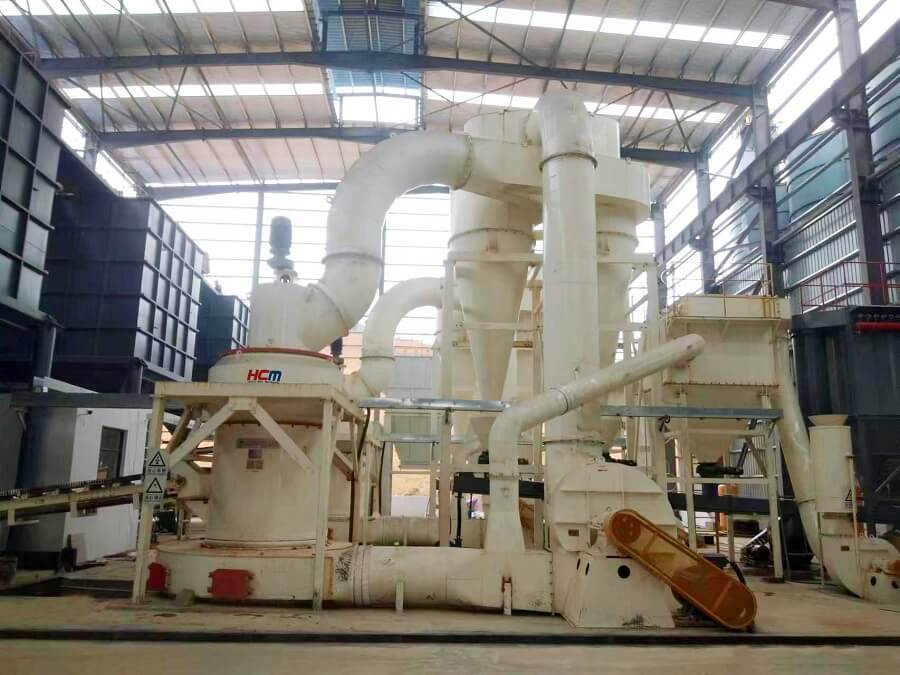Welcome to Guilin HCM Machinery Official WebSite!
Release date: 2023-12-08 09:30:26
HCM Machinery vertical mill desulfurization system has a smooth process flow, saves investment, is quick to start up, and is easy to produce and manage. When selecting the desulfurization limestone powder production process plan and equipment selection, adopt mature and reliable new processes and new technologies that are economical, reasonable, practical and reliable. As a designer and manufacturer of vertical mill desulfurization systems, HCM Machinery will introduce to you the desulfurization effect of vertical mills today.

Several main factors affecting desulfurization efficiency
1. Limestone grade
The grade of limestone is determined by the CaO content. The highest CaO content of pure limestone is 56%. The higher the purity of the limestone, the better the desulfurization efficiency. As a process designer, when designing ingredients, you must not only calculate its chemical composition, but also understand its physical properties. The calcium oxide content of first-grade limestone is 48%-54%; limestone does not necessarily require a higher CaO content, the better. Limestone with CaO>54% has high purity and is marbleized, difficult to grind, and has strong chemical stability, so it is not suitable for use as a desulfurization agent.
2. Fineness of limestone powder
The smaller the particle size of limestone powder particles, the greater the mass specific surface area. Since the dissolution reaction of limestone is a solid-liquid two-phase reaction, the reaction rate is proportional to the specific surface area of the limestone particles. Therefore, finer limestone particles have better dissolution performance, higher various related reaction rates, desulfurization efficiency and limestone utilization rate. Higher, but the smaller the particle size of limestone, the higher the energy consumption of crushing. Limestone powder is usually required to have a screening rate of 95% through a 325 mesh sieve (44 microns).
At the same time, the particle size of limestone powder is related to the quality of limestone. In order to ensure that the desulfurization efficiency and limestone utilization rate reach a certain level, when the impurity content in the limestone is high, the limestone should be ground finer.
HCM Machinery’s limestone powder preparation technology using vertical mill desulfurization system
In the FGD process that uses limestone powder as a desulfurization agent, the limestone powder needs to go through a solid-liquid two-phase dissolution reaction, and the reaction rate is proportional to the specific surface area of the limestone particles. The smaller the particle size of the limestone particles, the greater the mass specific surface area. The limestone particles have better dissolution performance and higher various related reaction rates. However, the smaller the particle size of limestone, the higher the energy consumption of crushing. Limestone powder is usually required to have a screening rate of 95% through a 325 mesh sieve (44 microns). At the same time, the particle size of limestone powder is related to the quality of limestone. In order to ensure that the desulfurization efficiency and limestone utilization rate reach a certain level, when the impurity content in the limestone is high, the limestone must be ground finer. The traditional tube mill technology is used to prepare limestone powder, which consumes a lot of energy, has low output, has a complicated process, and is difficult to control the fineness and particle gradation. With the development of grinding technology, vertical mill grinding technology is adopted. Because it adopts the material layer grinding principle, it has low energy consumption (20-30% lower than the power consumption of tube mill), and the product has stable chemical composition and particle gradation. Uniform and simple process flow.
The limestone entering the factory is unloaded into the hopper by a truck or forklift. The limestone is crushed in the first stage. The limestone is fed into the crusher through a plate feeder. The feed particle size is generally controlled at 400-500mm, and the discharge particle size is controlled at about 15mm. The crushed limestone is sent into the limestone warehouse through conveyor equipment, and a single-machine dust collector is installed on the top of the warehouse to remove dust. After the crushed limestone is measured and batched by the speed-adjustable belt scale at the bottom of the warehouse, it is fed to the vertical mill by the belt conveyor for grinding. The finished product is limestone powder with a fineness of 250 mesh. The ground limestone powder is sent to the finished product warehouse for storage via a conveyor. The top of the storage warehouse is equipped with a single-machine dust collector for dust removal. The finished products are sent from the bulk machine located at the bottom of the warehouse into bulk tanks and transported by truck out of the factory.
Desulfurization effect of vertical mill
The vertical mill grinding process adopts the principle of material layer grinding, with adjustable grinding pressure, low noise, low energy consumption, small wear, strong adaptability to materials, simple process flow, and high system efficiency. The whole system operates under negative pressure, resulting in little dust pollution. The vertical mill grinding process has uniform product particle gradation and adjustable product fineness (the product fineness can reach more than 600 mesh). At the same time, the product fineness can be quickly measured and corrected.
HCM Machinery Vertical Mill has mature grinding technology in the field of desulfurization limestone processing. The mill is durable, has high output and low power consumption, and has perfect after-sales service. HCM Machinery has focused on the research and development and production of ore and slag mills for more than 30 years. The product quality is stable and reliable. Consultation For equipment quotations, please contact us by email:mkt@hcmilling.com